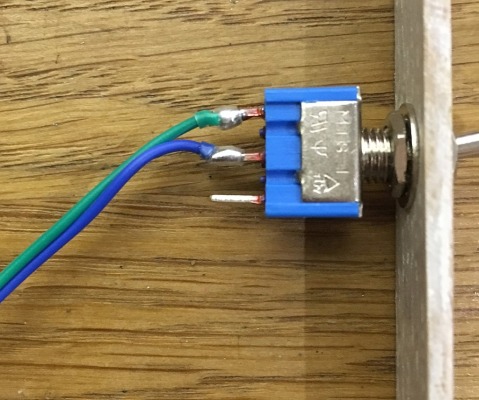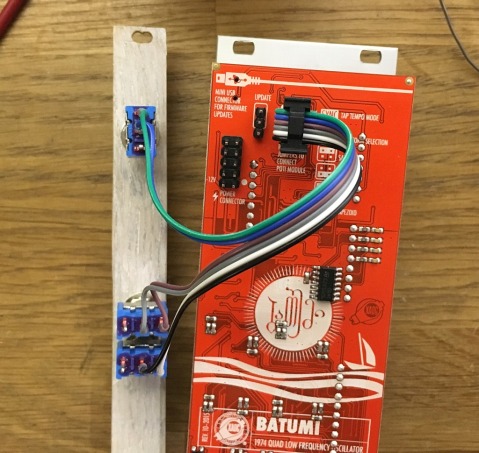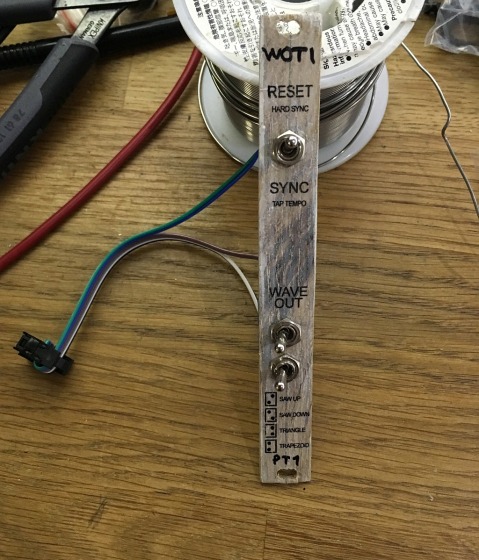ProtoTypo PT1 – WOTI
Yay it’s a firstie, my soft landing to the world of Eurorack: A DIY version of Xaoc Devices‘ POTI expander for Batumi (a quad LFO module). “What is ProtoTypo?” you might wonder? Then check my previous post.
The Build
Simple one yeah: three toggle switches mounted on a 3HP euro panel and connected to a 6-pin ribbon cable. Haven’t done anything this straightforward in ages, but still it’s a good crash course into eurorack mechanical specs and the like. As for Poti, there’s a good set of pictures of it at the Schneidersladen webshop, from which it’s easy to interpret wire connections.
Here’s a good generic build tip: As switches are connected to Batumi using flat cable (see photo below), it’s very much recommended to add some heat shrink tubing to cover solder joints. This is because flat cable is thin and flexible, and soldering any of its wires creates a sharp stiff-to-flexible transition point. If the cable is moved or flexed repeatedly then the wires will easily break off at this spot. So adding heat shrink over the joint will distribute the weight of cable to a wider area and thus lessen the risk of broken wires.
I have quite a neat leftover piece of this 4cm thick oak kitchen tabletop (from Ikea), so I figured I might just as well use some for building Euro panels. After all 4cm = 8HP (in Euro spec 1HP = 5.08mm / 1/5″) so it’s a perfect match size-wise. Once the oak is cut to 4HP slices 2mm thick, it’s very easy to trim down to required width. Simply running a sharp carpet knife along a ruler repeatedly will eventually create a straight groove deep enough to slice the thin wood panel in half. Minimal sanding required, yay \o/
So with panel cut & drilled, I treated it with white wood stain and then designed and printed a panel decal to a leftover Lazertran sheet (from my x0xb0x build btw!).
Now I have no clue if ‘Poti’ means anything, but I’m a big fan of abbreviations so I chose to call this build ‘WOTI’. That’s short for Wooden Output Toggle Interface. You know, oak panel and all! ;)
So there it is, ProtoTypo PT1. Of course I added it to Modulargrid.net too :). You can download the panel decal here for your own build. Poti manual is available from Xaoc Devices’ website.
The design of this module could be squeezed to 2HP too, provided that the switches were of sub-miniature type and/or oriented vertically. However I wanted a design to match Poti, so it was 3HP for me.
That’s that. Next up a ProtoTypo build with even some electronics in it!
Rate this:
Share this:
Related
Tags: 3hp, Eurorack, Expander, Extender, Poti, Prototypo, Toggle switch, Xaoc Devices
5 responses to “ProtoTypo PT1 – WOTI”
Trackbacks / Pingbacks
- ProtoTypo PT2 – GRAM | My Diy Blog - 08/02/2017






Resurrection! This looks great. I have been having issues with solder points breaking on my “Poti”. My thought is crimping these guys (pictured) to the splayed ends of the ribbon, then connecting corresponding ends to the posts on the Poti switches. Thoughts?
https://drive.google.com/file/d/1ZlVo93JHGheWHh0iEUWgJjcN2CZWdhAy/view?usp=sharing
Heya and thanks! Yeah crimp connectors should work, provided you solder the cable in place and the connection to switch is solid enough not to disconnect by itself for the added weight.
However you might want to consider some other type of crimp connector, for the type in your picture is designed for much thicker cables. So a regular, thin flat-cable is very likely to not have proper stress relief support, or slip off the connector if not soldered and.. And even if you use the correct crimping tool for the connector! On the other hand, if you use a thicker cable (for stress relief support to work) I’m not sure how that will work out at the Batumi end of things.
Just to suggest Something Completely Different: How about the Dupont style jumper wire cables for Arduino that are cheap to buy f.ex. off Ebay? Those have the connector readily crimped (saves you buying the correct tool) and you can split away the correct number of wires for your application. At the switch end, you can solder in a regular 2.54mm / 100 mil (.100″) pitch pin header to connect cables. Just remember not to split the pin header into single pins, but rather use a single piece, then leaving empty/unused pins between the terminals of the switch as needed. It’s way easier to solder in place this way.
I’ve used these cables for interconnects with prototyping and some builds too, and they’ve been pretty solid for the use. The combination does require some extra height to accommodate both the pin header and the Dupont crimp connector though. Still, in Eurorack terms and for panel switches, the two make for an entirely “skiff friendly” one :)
i soldered terminal headers onto the ends of the bare ribbon cable ends, they slip right onto the Poti posts. I really like Xaoc Devices but the expander connection is a joke. Why no pins instead of terminal posts? How could they think this was solid engineering? Actually a little salty over how they built this expander. So many simple things could have been done to make a more solid connection point. Before modding mine, I just left it sit in a box for months because of being too busy to fix it, its just shocking how easily the connections broke. Just some thoughts.
I think most often these design choices of eurorack modules simply boil down to kit / build costs. Small-batch manufacturers simply don’t have the leverage of large mfg batches to negotiate bulk buy discounts like the big ones do. Anything ‘mechanical’ is often the most expensive portion of components needed to make a piece of gear, so it makes one easy target to save up on final price tag.